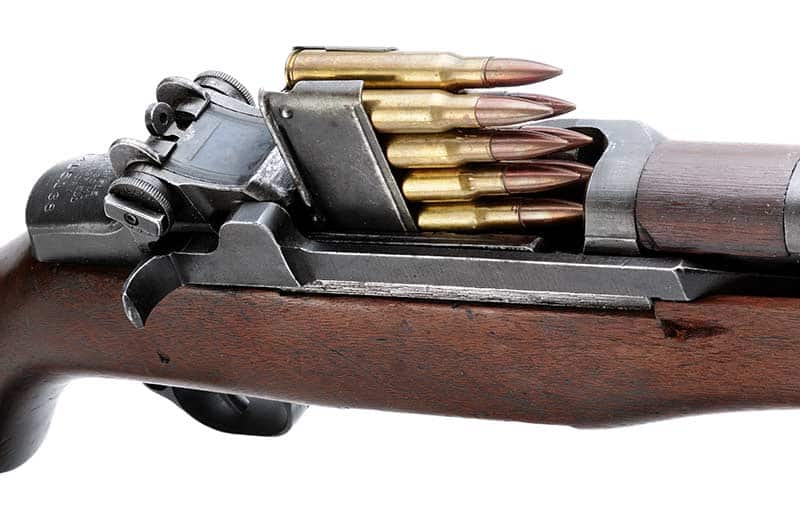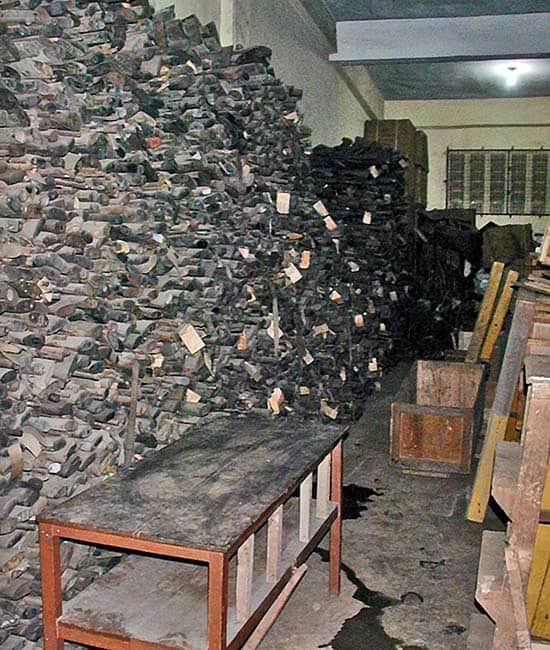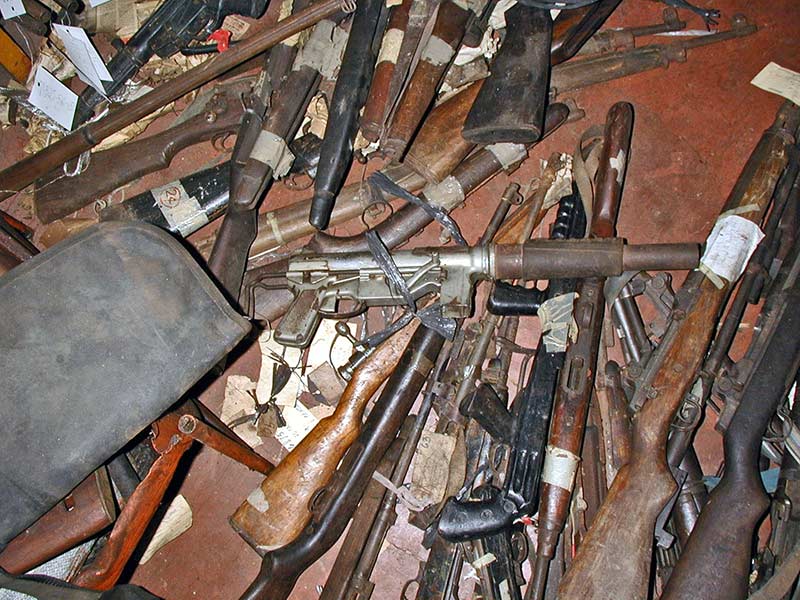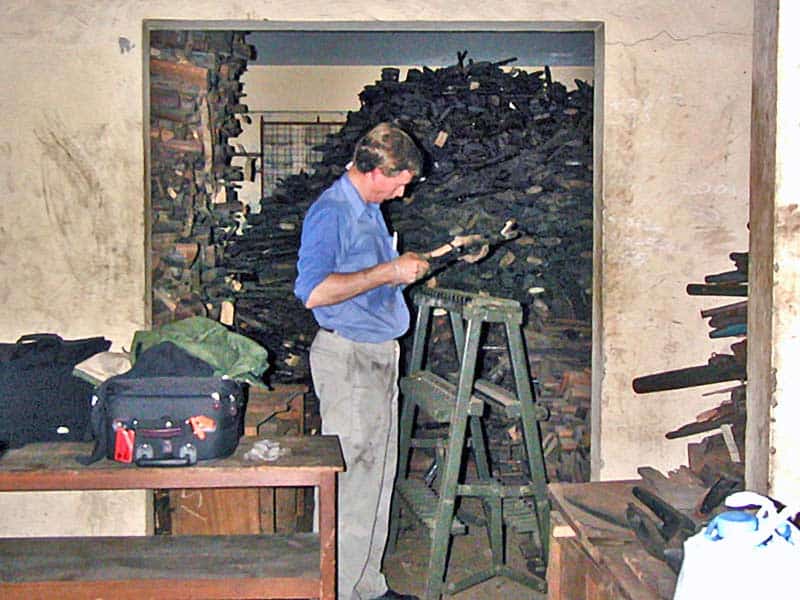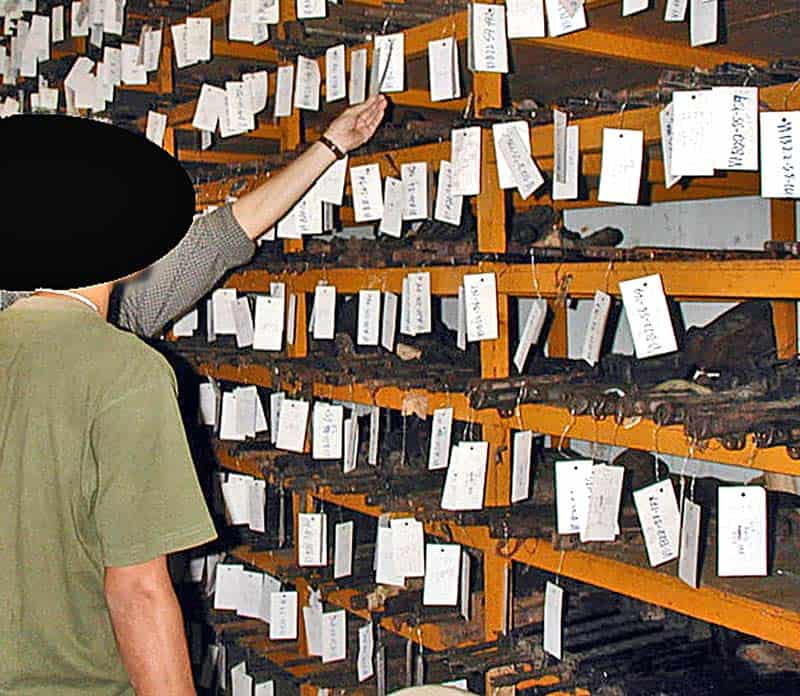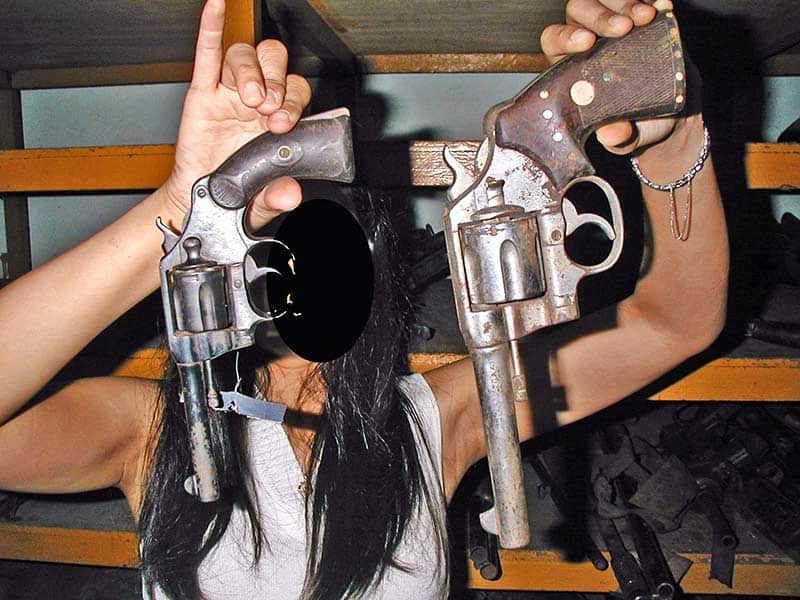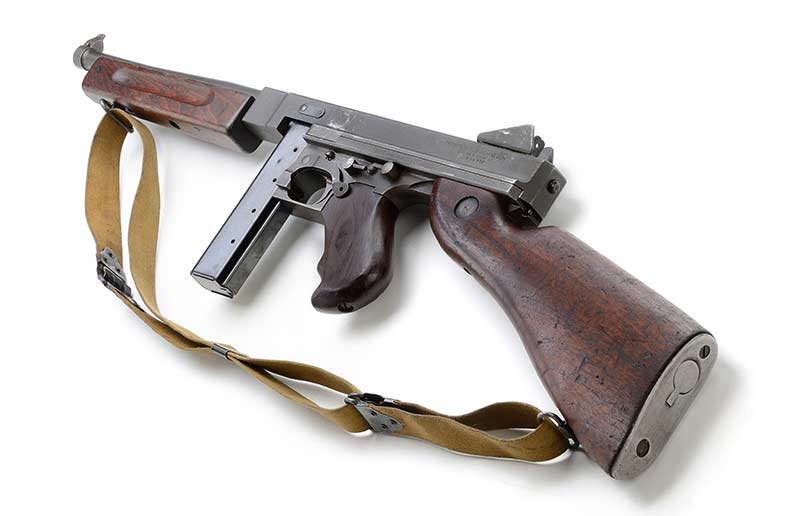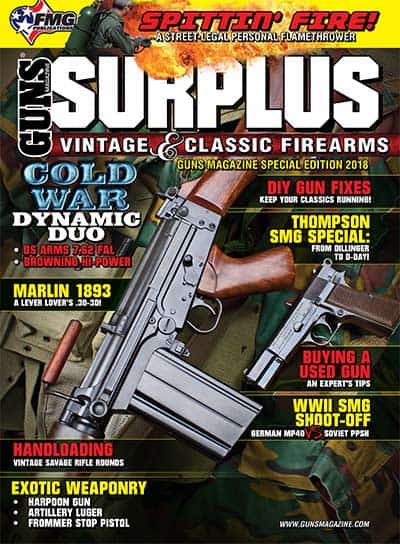A Garand Adventure
Recovering a treasure trove of mint
Philippine M1’s leads to much, much more
In the late 1980’s, the name Blue Sky became famous among American military arms enthusiasts when the company began buying and importing M1 rifles from South Korea. Before it came to an end, they brought in 200,000. How they found what amounted to the Holy Grail for WWII weapons collectors is a tale for another time. My story begins in their wake, as other intrepid businessmen sought out new weapons caches hoping to replicate Blue Sky’s success.
Those hopes were extinguished in the Clinton era, and rekindled when President George W. Bush took office. It was during this latter period I got an unexpected opportunity to assist in a private enterprise to determine what WWII small arms the Philippine government might still have; if they were interested in disposing of that materiel; and ideally, to facilitate its sale to two interested American business parties. For me it was an adventure. From the standpoint of the sponsoring business interests, it ranged from simple failure to outright debacle. Over a decade later it might be generously called a learning experience, but I will keep the dates vague and change or omit the names of all parties involved to protect the dignity of the Americans who deserve it — and perhaps the careers and freedoms of some of the Filipinos, who may or may not deserve it.
From The Git-Go
Indirectly, I got this adventure started when the president of Company X, a friendly acquaintance, asked me if I could find out anything about 55,000 mint condition M1 rifles he believed were held by the Philippine military. Despite the fact the current Republican administration hadn’t rolled back the legal impediments blocking the importation of American war materiel, he believed exceptions would be made for these M1’s because the vice president himself was interested in them. He claimed he learned this from a very respected firearms attorney he had employed to assist him on the project. As a favor, I passed his information request on to some well-placed Filipino acquaintances.
Culturally, Filipinos share a special extended personal connectivity with each other based on family, friendships, loyalty and favors which they rely on to facilitate their personal and business affairs. I thought there might be a chance my contacts knew someone, who knew someone, who knew someone. It turned out they did. They confirmed the existence of the big cache of Garands under military control and, to my surprise, several thousand more mixed American and Japanese weapons held by the Philippine National Police (PNP). There were no US obstacles to importing vintage Japanese rifles. Another firm, Company Z, ended up getting involved. That was the good news.
The bad news was a large Filipino firearms dealer, whom I’ll simply call “the middleman,” was positioned between the American companies and both the Philippine military and PNP. My contacts couldn’t see any way around the middleman.
On the positive side, the middleman had a vested interest in seeing a deal made, was willing to set up meetings for us, had the trust of both government parties, the ability to export firearms from the Philippines and had tried at least once before to arrange a sale without success. This was ostensibly due to the previously mentioned import restrictions. Their relationship with the government was too cozy by American business standards, but this was Manila, not Washington, D.C.
The enterprise was probably doomed from the start, but I didn’t know enough of the facts to realize it at the time. My role was unofficial and I participated at my own expense out of a romantic spirit of adventure. If anyone asked, I was there to inspect the rifles for my friend at Company X. My other American companions were the business representatives from Company X and Z. It wasn’t long after meeting with the middlemen it became apparent Company X wasn’t willing to — and probably wasn’t even capable even of — meeting the Philippine military’s requirements to begin negotiations. They could neither establish a track record of firearms importation nor demonstrate the financial solvency to complete a deal. Company X wasn’t the first firm to try to buy those 55,000 M1 rifles, and the middlemen, suspecting their time was being wasted, were not about to squander the confidence of their valuable military contacts. I never got to see any of those supposedly mint M1 Garands.
Later I learned the middlemen were looking for a selling price of $200 per rifle, half to be invoiced by the government, and the other half by the middlemen. In light of the middlemen’s seemingly small role, this had all the appearances of a thinly veiled bribe, and had Company X known this to be true, it would be to their credit if they walked away from the deal. I’ve since learned what we consider corruption and bribery is what most of the Third World considers the normal cost of doing business.
Plan B
As Company X’s hopes crashed and burned, our full attention turned to Company Z’s interest in the historic weapons confiscated by the PNP. Unlike the military, they seemed more accessible and eager to strike a deal with Company Z to trade for new guns and gear to equip their officers. To my amazement, the middlemen arranged a meeting at PNP headquarters to meet the top PNP officials on the day the president of the Philippines was coming to give a nationally televised speech on how the agency was addressing an epidemic of car jackings across the county.
While my colleagues attended their meeting, I stood outside the building and watched the president’s motorcade arrive along with at least 20 reporters and TV camera crews. None of the Filipinos appeared concerned about my presence, as their leader took the microphone less than 10 feet to my left. At the conclusion of her speech, she answered a few questions from the news media and departed.
After she drove away, I suddenly became aware all eyes were on me. The reporters circled me with their cameras and microphones wanting quotes regarding America’s position on various security matters of national interest. Clearly they had mistaken me for someone actually important. It took all my willpower to restrict my remarks to “no comment” as I retreated into the PNP headquarters building to hide out.
When the middlemen and the remaining American in our party finally emerged from the meeting, I learned the PNP had granted us access to their storage warehouse to inspect their old confiscated weapons slated for destruction. Finally, I thought, I’m going to get to see something other than jeepneys, traffic jams, the inside of our hotel, the increasingly suspect middlemen and our pretty Filipina interpreter, the latter being the only bright spot of our otherwise disappointing trip.
Rusty Treasures?
The PNP warehouse was a big deteriorating one-story concrete structure showing a basic neglect common to cash-strapped public facilities in the Third World. A tired policeman on duty in the small foyer made a perfunctory check of our bags. This building had few visitors. Once inside, our first impression was promising. We came into a narrow corridor flanked by long horizontal wooden racks going from floor to ceiling. One was filled with a few hundred M1 rifles with a dozen or so Soviet PPSH-41 submachine guns mixed in for spice, each with a paper tag tied to the muzzle. The M1’s were decent looking guns, a few noticeably incomplete, but certainly saleable. The area was illuminated by natural light coming through large, translucent glass windows secured with heavy steel mesh.
The colonel escorting us had a few words with a pair of sweaty, T-shirt clad civilian warehouse workers inside and left us under their supervision. They spoke no English. After a few words from our Filipino middlemen, they turned us loose to do our inspection. Occasionally they would walk over to us to silently observe for a few moments before walking off again.
Our high hopes for better vintage arms inside sank, then plummeted, as we worked our way through the various rooms of the warehouse. It was a surreal experience. As a whole, it was very dirty, shockingly disarrayed and poorly lit. Some rooms had wooden racks, but most simply had the long guns stacked horizontally in great piles on the floor, when they were not just strewn around the ground intermixed with beat up wooden and cardboard boxes of every description filled with handguns, and sometimes ammunition. It was a wild mixture of military and civilian guns ranging from decrepit 1873 Colt six-shooters from the Spanish American War to FAL FN rifles. There was even a rusty coat hanger with six extremely rare FP-45 Liberator pistols strung on it hanging on a peg. Most of the guns were filthy and rusty from neglect. Whatever the duties of the warehousemen were, it did not include oiling the weapons. The tropical humidity, as well as the rainwater coming in unobstructed through the broken windows had taken its toll. There were a few anomalies like four brand new IMI UZI submachine guns new in their boxes. Huh?
Our inspection now took on the aspect of a treasure hunt. There were thousands of guns in there, and maybe 10 percent of them were rare, decent or collectable enough to be worth importing, even if just for parts. About half of the inventory was World War II- era US or Japanese military, which we were told were captured from the New People’s Army (NPA), a communist insurgent group that is still active in the islands. Some of these rifles sported odd 15- or 20-round box magazines, apparently having been modified in the NPA’s jungle workshops.
We searched the piles and boxes amid bright shafts of sunlight filtering in from steel meshed windows, cutting up the semi-darkness with small checkerboards. These bright areas made it hard to see anywhere else in the rooms, which were at best lit by scattered fluorescent lights hung from the bare wooden ceiling rafters high above. Some gems hid in the shadows. A stack of military 50-round Thompson submachine gun drums, an OSS silenced M3 Grease Gun and massive tripods for Japanese Type 3 heavy machine guns teased us.
One room had pump shotguns piled higher than my head against a back wall next to a waist-high pile of Browning Automatic Rifles (BAR) and M3 submachine guns mingled in among various World War II-era American made riot guns. I picked up a rusty Model 12 Winchester and saw it was martially marked. The next one revealed beneath it was a Winchester Model 1897 trench gun. There were dozens more in the pile, all genuine World War II martially marked shotguns. Though highly collectable, they were rough enough to make them a tough sell on the American market even if they could be imported.
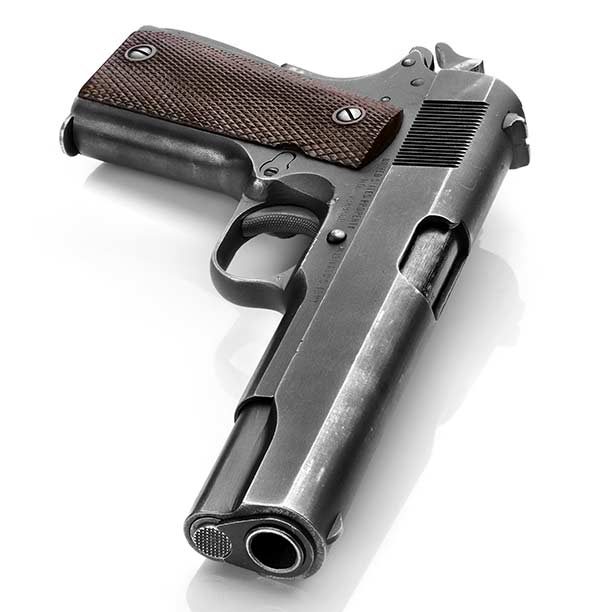
WWII-era 1911’s were in evidence. Frank said most of the guns were actually used by defending American and Philippine forces in WWII, while the Japanese guns — including heavy machine guns — were captured. The Arisakas still had the chrysanthemum crest, showing they were wartime captures, not de-milled ones.
Digging Deeper
As I moved from pile to pile indulging my curiosity examining M1917 Enfields, M1903 Springfields, M1 and M2 carbines, Garands, Grease Guns and BARs, I encountered two teenage boys involved in some inscrutable warehouse activity. They smiled at me and took it upon themselves to help me for several minutes despite my polite, and completely misunderstood, efforts in English to dissuade them. Fortunately, our little Filipina interpreter called them away. In her white sleeveless dress, she stood in stark contrast to the dingy dark surroundings. Trying to keep clean, she would stand in the few areas of floor that were relatively clear of martial detritus and general litter and far away from the stacks of rifles we were climbing up for fear of being buried should we cause an avalanche. I could see the teenagers chatting away with her happily, and that was the last I saw of them.
I could tell the American inspector from Company Z was disappointed, but was obviously reassessing the commercial prospects of this vast mess of small arms. There were lots of Arisaka rifles and carbines in varied conditions, from good to very poor. Most had the emperor’s chrysanthemum crest intact showing they were captured rather than surrendered. They might have appeal to collectors as genuine relics of the fighting in the Philippines. There were also a couple hundred vintage commercial and foreign military long guns and handguns with potential value for parts if nothing else.
I saw early Colt New Service .45’s, M1911’s, M1903 pocket pistols, Police Positives, S&W M&P .38’s, M1910 Savages and nearly every imaginable pre-war European autoloader from the C96 Mauser to the Walther P-38, as well as all the Japanese Nambu’s one could hope to encounter. My colleague from Company Z informed me, unfortunately, the junk far outnumbered the gems, and the majority of this stockpile would have been better off dumped into the sea. If he had to buy it all, that’s exactly what he planned to do.
After a few sweaty hours in the stuffy warehouse, we moved outdoors to inspect the last of the PNP-confiscated weapons deemed too crappy to be worth storing under a roof. Three 40-foot sea-land containers were positioned along a concrete dock which the warehousemen opened for us before taking shelter in the shade. We were told this materiel was destined for destruction in the very near future by the order of higher authorities in the Philippine government. The middlemen advised the PNP would be highly motivated to trade the contents for material they could use if an agreement could be made.
Pistols poured onto the ground in front of the first container when its door swung open. The other two were stacked to the roof with rusty long guns. In the bright light of day, it was easy to see the contents. The long guns were mostly WWII military models apparently no worse than those inside. There were a lot more Japanese Arisaka rifles here than inside, and there were a lot of Japanese light and heavy machine guns that could be broken down for valuable parts. I helped the representative from Company Z dig through the containers.
The warehouse was uncomfortable, but working in the containers cooking all day in the sun was worse and we were quickly soaked to the skin. It was here the real treasures unexpectedly lay. I dug in and pulled out Arisaka sniper rifles, multiple variations of the Nambu light machine guns, a few rare Japanese copies of the Lewis light machine gun and at least five of the massive finned barrel Type 3 heavy machine guns I’d already discovered the tripods for inside. Most of the guns were rusty, but strangely there were fine examples, well-greased, incongruously mixed in. My favorite discoveries were a mint M1928 Thompson and M3 submachine gun in dirt-caked cosmoline. We found the best Nambu pistols here too, almost all missing their fragile grips, but with heavy grease protecting their blued finish. I wanted to slip a few into my luggage, suspecting that for 1,000 pesos (about $20) the warehousemen would gladly look the other way, but the tired policeman checking bags at the gate gave me pause.
History In My Hands
The container full of handguns contained mostly curious Philippine-made copies of Colt and Smith & Wesson revolvers showing differing levels of fabricating expertise. We noticed similar arms were commonly carried by private security guards — along with a ubiquitous sawed-off pump shotgun. Upon examination, most had smooth bore barrels and the steel they were made of was very soft. I used one as a hammer and the grip frame bent after a few blows. Later I was told these weapons were clandestinely made in jungle workshops for extra-legal purposes.
Unlike Company X, the representative from Company Z entertained no expectations of getting an exception from the US Department of State to re-import American war materiel. Knowing this, we looked at our great American military finds with a sad realization they would never leave the islands. I held in my hands early 1903 Springfields, 1918 BAR’s and M1928 Thompsons which had probably been in the hands of American and Filipino soldiers as they made their fighting withdrawal down the Bataan Peninsula in 1942. Because these guns had never really left their battlefields, there was a stronger than normal sense of history about them.
I recalled I needed the small screw retaining the magazine cut off in the Springfield and decided I could at least bring that home. I took a rifle from the container and swung it against the concrete dock smashing the stock off at the wrist. The Filipino warehousemen didn’t bat and eye. I took another swing to break off the last part of the wood and expose the little screw but hit the receiver tang instead. To my shock, the receiver broke cleanly in two. I looked at the serial number. It was a low number which is said on good authority to have been subject to heat treating mistakes. I’d always read those low number rifles were best not fired because they might be brittle. There in my hands was the broken fragment demonstrating the oft-repeated story to be true — and I couldn’t bring it home. I took my tiny screw and threw the broken rifle back in the container. The representative from Company Z gave the warehousemen 1,000 pesos and took some rare Japanese sniper riflescope mounting parts with him for his trouble.
Excitement Ensues
When we finally finished our inspection around 5:00 p.m., did our departing bag inspection and left the PNP compound and middlemen, it was just the intrepid man from Company Z, our young Filipina interpreter and myself in our hired car. There was a weary silence as we drove through afternoon traffic to our hotel. After a few minutes our interpreter asked us what we thought. Almost simultaneously we replied it was a shame we couldn’t take any of those 50-round Thompson drums home with us to help pay for the trip. She looked at us oddly and asked, “Why didn’t you tell me that when we were there?” A bit confused, I asked her what she meant by that remark.
She explained the two boys I’d tried so hard to shake were from her province and they didn’t speak any Tagalog so they’d become quite lonely working at the compound with nobody to talk too. When they realized she spoke their home dialect, they were delighted and talked to her for almost two hours. They told her if she wanted anything from the warehouse they would take it out for her because the police never search them.
Though there was interest on both sides to strike some sort of deal for what was officially considered scrap by the authorities, an unexpected twist on the last day of the Company Z man’s stay in the Philippines soured everything. As he was leaving through customs, the inspectors found some innocuous looking metal parts in his luggage and asked what they were. He honestly answered they were vintage rifle parts and was arrested on the spot. He had naturally done nothing wrong, other than fail to realize how widespread corruption really was in the Philippines. The inspectors sized him up as having the means to pay a bit of extortion money and had he offered them a moderate bribe, he surely would have made his plane. Instead, he maintained his innocence and was placed under house arrest at his hotel with a guard outside the door in the hallway.
The petty graft of the customs inspectors ended up backfiring on them. Our ever-helpful interpreter made a few calls and secured his official release, showing up at his room and sending the guard home with 500 pesos. I heard later the customs man responsible for the shakedown was fired. Apparently someone with some power saw the man from Company Z as valuable enough to protect, but the damage was done. Understandably, Company Z also lost interest in the project. From a Western business perspective, there seemed to be no clear chain of authority with just too many palms looking to be greased with no guarantee of success.
I don’t know what happened to the materiel we saw at the PNP warehouse. It was never imported to the United States to my knowledge. In a weird turn of events, the M1 Garands I never got to inspect for Company X are finally coming to America. In May, the Civilian Marksmanship Program (CMP) announced the Philippine government was returning their stocks of M1 Garand rifles, which would in turn be donated to the CMP for sale to qualified members of affiliated clubs across the country. I might just get one, as a belated souvenir of a very memorable trip.

